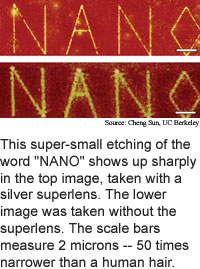
Thin silver sheet makes superlens
An ordinary lens can focus light to about
half the light's wavelength. Visible lightwaves range from 400 to 700
nanometers, and ultraviolet lightwaves range from 10 to 400 nanometers.
Researchers from the University Of California at Berkeley have
fashioned a superlens from a thin sheet of silver that resolves images
as small as 60 nanometers using 365-nanometer light.
The superlens could be used in super-resolution microscopes, and
promises to extend the ability of existing chip-manufacturing plants to
make the smaller transistors that lead to faster computer chips and smaller
bits that increase storage capacity, according to the researchers.
Super resolution imaging is possible because the silver lens has
a negative index of refraction. Ordinary lenses have a positive index
of refraction. A positive index of refraction causes light to bend as
it passes from one material to another; this is what causes the bent-drinking-straw
illusion where air meets water. A negative index of refraction causes
light to bend in the opposite direction.
Negative index of refraction materials also amplify evanescent
light -- the light field immediately around an object that ordinary lenses
can't pick up. The evanescent light conveys finer details about an object
than ordinary, or propagating, light.
Existing near-field microscopes makes super resolution images
by capturing evanescent light, but can only scan objects point-by-point.
Superlenses image whole objects at once.
When the researchers shown 365-nanometer-wavelength ultraviolet
light through a chromium mask containing 40-nanometer lines forming the
word "nano" the superlens produced images focused to 89 nanometers, well
below half the light's wavelength.
The lens could be used in practical applications in one to five
years, according to the researchers. The work appeared in the April 22,
2005 issue of Science (Sub-Diffraction-Limited Optical Imaging
with a Silver Superlens).
Stories:
Machine reproduces itself
Conference system makes shared space
Nanotube memory scheme is magnetic
How It Works: Robot navigation
Briefs:
Nanoparticles drive display
Thin silver sheet makes superlens
Catalyst boosts gasoline fuel cells
Virtual DNA makes material

Research Watch blog
View from the High Ground Q&A
How It Works
RSS Feeds:
News
Ad links:
Buy an ad link
Ad links: Clear History
Buy an ad link
|
TRN
Newswire and Headline Feeds for Web sites
|
© Copyright Technology Research News, LLC 2000-2010. All rights reserved.